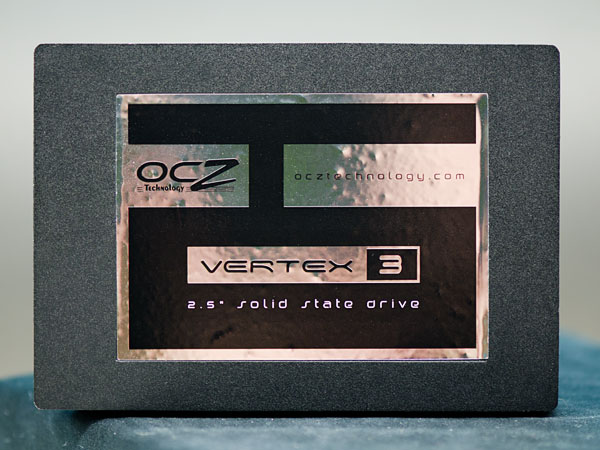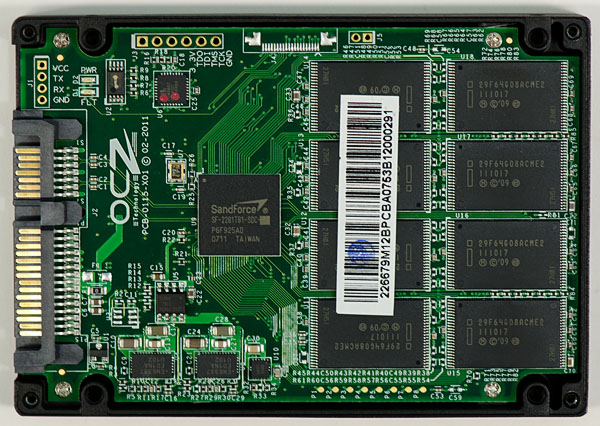The OCZ Vertex 3 Review (120GB)
by Anand Lal Shimpi on April 6, 2011 6:32 PM ESTThe Vertex 3 120GB
Whenever we review a new SSD many of you comment asking for performance of lower capacity drives. While we typically publish the specs for all of the drives in the lineup, we're usually only sampled a single capacity at launch. It's not usually the largest, but generally the second largest and definitely an indicator of the best performance you can expect to see from the family.
Just look at the reviews we've published this year alone:
Intel SSD 510 (240GB)
Intel SSD 320 (300GB)
Crucial m4 (256GB)
While we always request multiple capacities, it normally takes a little while for us to get those drives in.
When OCZ started manufacturing Vertex 3s for sale the first drives off of the line were 120GB, and thus the first shipping Vertex 3 we got our hands on was a more popular capacity. Sweet.
Let's first look at the expected performance differences between the 120GB Vertex 3 and the 240GB drive we previewed earlier this year:
| OCZ Vertex 3 Lineup | |||||
| Specs (6Gbps) | 120GB | 240GB | 480GB | ||
| Max Read | Up to 550MB/s | Up to 550MB/s | Up to 530MB/s | ||
| Max Write | Up to 500MB/s | Up to 520MB/s | Up to 450MB/s | ||
| 4KB Random Read | 20K IOPS | 40K IOPS | 50K IOPS | ||
| 4KB Random Write | 60K IOPS | 60K IOPS | 40K IOPS | ||
| MSRP | $249.99 | $499.99 | $1799.99 | ||
There's a slight drop in peak sequential performance and a big drop in random read speed. Remember our discussion of ratings from earlier? The Vertex 3 was of course rated before my recent conversations with OCZ, so we may not be getting the full picture here.
Inside the 120GB Vertex 3 are 16 Intel 25nm 64Gbit (8GB) NAND devices. Each device has a single 25nm 64Gbit die inside it, with the capacity of a single die reserved for RAISE in addition to the typical ~7% spare area.
The 240GB pre-production drive we previewed by comparison had twice as many 25nm die per package (2 x 64Gbit per NAND device vs. 1 x 64Gbit). If you read our SF-2000 launch article one of the major advantages of the SF-2000 controller has over its predecessor is the ability to activate twice as many NAND die at the same time. What does all of this mean for performance? We're about to find out.
RC or MP Firmware?
When the first SF-1500/1200 drives shipped last year they actually shipped with SandForce's release candidate (RC) firmware. Those who read initial coverage of the Corsair Force F100 drives learned that the hard way. Mass production (MP) firmware followed with bug fixes and threatened to change performance on some drives (the latter was resolved without anyone losing any performance thankfully).
Before we get to the Vertex 3 we have to talk a bit about how validation works with SandForce and its partners. Keep in mind that SandForce is still a pretty small company, so while it does a lot of testing and validation internally the company leans heavily on its partners to also shoulder the burden of validation. As a result drive/firmware validation is split among both SandForce and its partners. This approach allows SF drives to be validated heavier than if only one of the sides did all of the testing. While SandForce provides the original firmware, it's the partner's decision whether or not to ship drives based on how comfortable they feel with their validation. SandForce's validation suite includes both client and enterprise tests, which lengthens the validation time.
The shipping Vertex 3s are using RC firmware from SandForce, the MP label can't be assigned to anything that hasn't completely gone through SandForce's validation suite. However, SF assured me that there are no known issues that would preclude the Vertex 3 from being released today. From OCZ's perspective, the Vertex 3 is fully validated for client use (not enterprise). Some features (such as 0% over provisioning) aren't fully validated and thus are disabled in this release of the firmware. OCZ and SandForce both assure me that the SF-2200 has been through a much more strenuous validation process than anything before it.
Apparently the reason for OCZ missing the March launch timeframe for the Vertex 3 was a firmware bug that was discovered in validation that impacted 2011 MacBook Pro owners. Admittedly this has probably been the smoothest testing experience I've encountered with any newly launched SandForce drive, but there's still a lot of work to be done. Regardless of the performance results, if you want to be safe you'll want to wait before pulling the trigger on the Vertex 3. SandForce tells me that the only difference between RC and MP firmware this round is purely the amount of time spend in testing - there are no known issues for client drives. Even knowing that, these are still unproven drives - approach with caution.
The Test
| CPU |
Intel Core i7 965 running at 3.2GHz (Turbo & EIST Disabled) Intel Core i7 2600K running at 3.4GHz (Turbo & EIST Disabled) - for AT SB 2011, AS SSD & ATTO |
| Motherboard: |
Intel DX58SO (Intel X58) Intel H67 Motherboard |
| Chipset: |
Intel X58 + Marvell SATA 6Gbps PCIe Intel H67 |
| Chipset Drivers: |
Intel 9.1.1.1015 + Intel IMSM 8.9 Intel 9.1.1.1015 + Intel RST 10.2 |
| Memory: | Qimonda DDR3-1333 4 x 1GB (7-7-7-20) |
| Video Card: | eVGA GeForce GTX 285 |
| Video Drivers: | NVIDIA ForceWare 190.38 64-bit |
| Desktop Resolution: | 1920 x 1200 |
| OS: | Windows 7 x64 |












153 Comments
View All Comments
sor - Thursday, April 7, 2011 - link
Oh sure, I agree that the bottom line is whether or not it still works, that's why they do the binning and have grades of product within that brand. If OCZ can use cheaper flash and the controller takes care of the increased failures, or the users never reach the failure threshold, then who cares, as long as the product works the same?I can't speak for the testing procedures within SpekTek or their tolerances, as I only worked for a facility that tested parts for Micron, and in the process generated the bad parts and did some of the binning before sending them to SpekTek. Much of the stuff that went to them failed our tests but was otherwise not physically damaged.
There's a reason why those parts are sold under the SpecTek brand at a discount, it shows that even the manufacturer doesn't trust them to be sold under the good brand after testing.
Panlion - Thursday, April 7, 2011 - link
I wonder if OCZ will produce a 7mm 2.5 inch drive. The newer notebooks from Lenovo are starting to demand that format it'll be nice if I can have some option other than Intel SSD.sleepeeg3 - Thursday, April 7, 2011 - link
Maintaining integrity while sticking out for the little guy, instead of bending over backward to write glowing articles for every vendor sponsor. That's what has made this site succeed.I wish you could also take OCZ to task on SandForce's controller strange tendency to lock up and vanish from a system, due to built in encryption. They are in complete denial that it is an issue, despite dozens of reports on their user forums.
edfcmc - Thursday, April 7, 2011 - link
Thank you Anand for this very informative and in-depth review of the OCZ issue and their latest 120gb vertex 3 product; especially since the 120gb products are within my price range and the size I am looking to purchase. On a side note, I have been reading your reviews since your review of the FIC PA-2007 many years ago and I love the evolution of this site and your dedication to keeping us consumers informed.p.s. Please consider asking asus/Nvidia to update the Nvidia driver on their ULV80 series as nothing new has been updated since I purchased the UL80vt based on this site's recommendation. Asus/Nvida seem to be a little non-responsive to us folks who have been requesting an update for quite some time.
ekerazha - Thursday, April 7, 2011 - link
Can't wait for reviews of SSDs (Intel G3, Crucial m4) with comparable size (120 GB).Chloiber - Thursday, April 7, 2011 - link
Anand:Just a quick note. In the newest SF-firmware, there is also still a bug with Hynid Flash. You can see it here, under "Open Issues":
http://www.ocztechnologyforum.de/forum/showthread....
"Under benchmarking scenarios with IOMETER 2006, 60GB drives that use Hynix32nm MLC (1024 blocks, 8KB pages) can impose long latencies"
Just FYI.
MarcHFR - Thursday, April 7, 2011 - link
Dear OCZ, Dear Anand,In the past, it was simple :
Vertex : always the same NAND
Agility : NAND could change
I know that Vertex name is a best seller for OCZ, but i think it will be simplier to back to this
strikeback03 - Friday, April 8, 2011 - link
That is what I was wondering, I thought the point of the Agility line was that they would use the good controller but possibly cheaper NAND.Adul - Thursday, April 7, 2011 - link
Why not make use of QOR codes so a shopper can just scan the code to be taken to a page with more detail information.miscellaneous - Thursday, April 7, 2011 - link
Given this particularly insidious paragraph:"OCZ will also continue to sell the regular Vertex 2. This will be the same sort of grab-bag drive that you get today. There's no guarantee of the NAND inside the drive, just that OCZ will always optimize for cost in this line."
Will these "grab-bag" drives be using the same SKU(s)/branding as the original - well reviewed - Vertex 2? If so, how is using the _old_ SKU(s) to identify the _new_ "grab-bag" drives, whilst introducing _new_ SKU(s) to help identify drives with the _old_ level of performance a satisfactory solution?